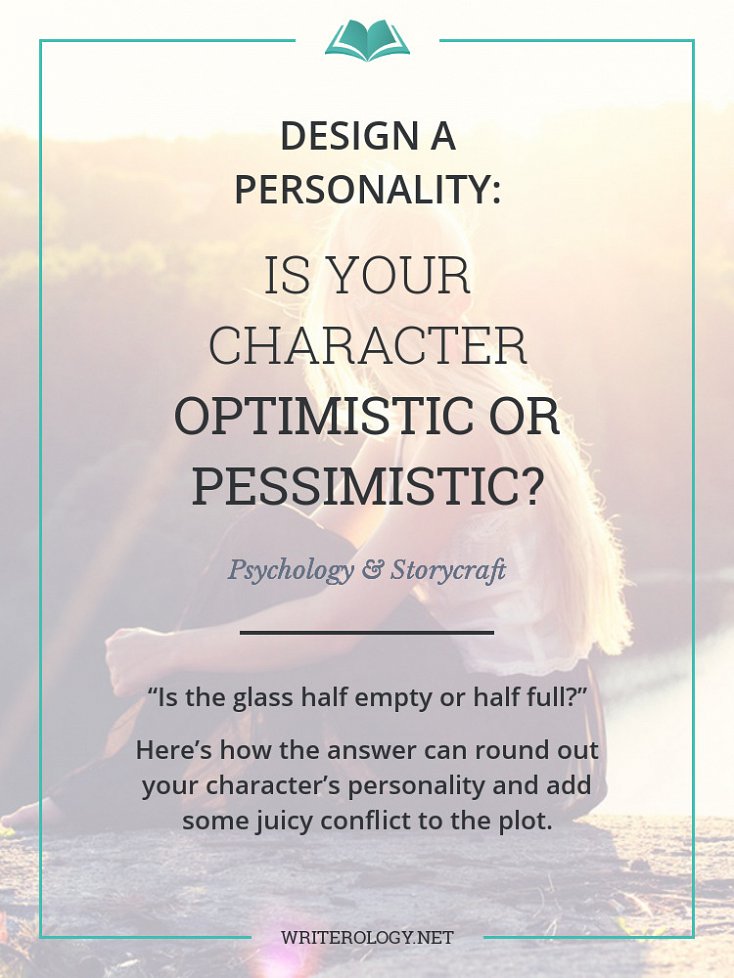Design a Personality: Is Your Character Optimistic or Pessimistic?
Is your character an optimist or pessimist? The answer can help you to round out your character’s personality and add some juicy conflict to a plot.
Is the glass half empty or half full?
You’re probably familiar with the expression. It’s a common litmus test of sorts to determine your view of the world and your outlook on a situation. Depending on how optimistic or pessimistic you are, your answer to the question will vary.
Why? Both optimists and pessimists see the same glass, but their interpretation of it differs. That raises an important point for writers: your characters’ narratives are not objective. They’re subjective, tinted by their individual worldviews, coloured by their personalities and thought patterns and experiences.
No two people (or characters) see the world in the same way, and something as simple as an optimistic or pessimistic streak can have a significant impact on that. If you think about it that way, how your character interprets the glass half empty or half full question can be quite the game-changer.
So what makes someone more optimistic or pessimistic and where do your characters fall on the continuum? Let’s take a look at Martin Seligman’s explanation of these two ways of thinking.

According to Seligman, the way you choose to explain what happens to you can control your view of the world. Your explanatory style—how you explain your problems and choose a solution to them—can be positive or negative, and it's this habit of thinking that makes you more optimistic or pessimistic. Most people fall somewhere between the two extremes, with varying degrees of optimism and pessimism, and so should your characters.
Optimism and pessimism aren't necessarily something you're born with and stuck with for the rest of your lives. Though there's a tendency to be one or the other, both can be learned—and that itself comes with positive and negative consequences.
Related post: Design a Personality: Building Rock-Solid Character Traits
Learned Helplessness
It's all too easy to fall into the trap of pessimism. When faced with the feeling that life is uncontrollable, giving up and surrendering to negative thoughts can be an irresistible temptation. You stop trying to change what seems unchangeable. You learn to be helpless.
This often happens in unpleasant situations that seem unavoidable or inescapable. In Seligman's original research, dogs laid down, became passive and didn't try to escape the electric shock they kept receiving. Humans also fall foul of this—when unable to get away from very loud noises, many of the people Seligman studied simply gave up, just like the dogs. They learned to be helpless.
Explanatory style can have a significant effect on learning to be helpless. It's much more likely to happen if you view negative situations as:
- Personal—the situation is your fault.
- Permanent—it isn't going to change.
- Pervasive—it affects your whole lives.
People who explain negative situations like this become pessimistic, believing that these bad things will have a longer and greater impact on their lives than those who view these situations differently.
What about optimists? If you can learn to be helpless, can you do the opposite?
Learned Optimism
Not everyone learns to be helpless. In the previous examples of inescapable situations, around a third of dogs and humans didn't give in and accept their fate. They remained resistant to the lure of pessimism and instead looked for ways to escape. They learned to be optimistic.
Seligman attributes this to an explanatory style that differs from pessimists in several ways. In this case, you view negative situations as:
- Circumstantial—the situation isn't your fault, just an unfortunate event.
- Temporary—the situation will change and get better.
- Specific—only this situation is negative, not your whole lives.
If you explain what happens to you in this way, you'll be far more active in changing situations for the better.
Related post: Design a Personality: Giving Depth and Flexibility to Your Characters